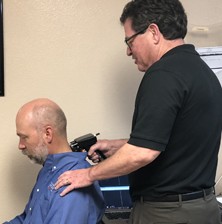About Blair Chiropractic Technique
FREE Consultation
For the first half of his career as a chiropractor, Dr. Dennis Campbell practiced the popular diversified technique with much success. After attending a seminar with the late Dr. Sigafoose in 2000, he returned home curious about Upper Cervical and began inquiring with his personal chiropractor.
He began visiting a local Upper Cervical chiropractor, and soon his own low back pain – which hadn’t ever fully resolved with traditional chiropractic care – went away! He also noticed an improvement in his immune system, not catching colds with the same frequency and intensity whereas he’d previously caught a few each year.
“I had to wonder,” says Dr. Campbell, “how this new type of adjusting was affecting my immune system.”
How Does Upper Cervical Chiropractic Work?
Soon after, Dr. Campbell got the training and made the changes necessary to change over his own practice to one implementing the Upper Cervical adjustment, and did so with phenomenal results. Today this is his exclusive method of adjustment.
Just as in traditional chiropractic philosophy, Upper Cervical chiropractic stems from the fact that the nervous system is housed by the spine.
When spinal joints (vertebrae) are out of alignment or otherwise placing pressure on a nerve, this causes interference in the signals that control bodily functions.
When there is interference, these signals aren’t allowed to freely flow between the brain and all of the muscles, tissues, and organs the brain controls.
Upper Cervical chiropractic – and specifically the Blair Technique – is further aware of two very important facts:
The first vertebra in the spine – your atlas – is one of only two vertebrae in your body that can’t self-correct when they become misaligned.
When the atlas is IN correct alignment, other misalignments below it in the spine do tend to self-correct, whereas if the atlas is OUT of alignment, they do not.
This raises a few questions:
If the atlas cannot self-correct – because of the neuromuscular structure surrounding it – how could an atlas misalignment be addressed outside of Upper Cervical chiropractic care?
How can any chiropractic adjustment performed below the atlas be expected to “hold” if the atlas remains misaligned?
Are other chiropractic adjustments below the atlas even necessary, if the atlas remains correctly aligned?
With a correctly aligned atlas, and a spine that self-corrects as a result, will the nervous system then be able to function at its optimal level? How would this improve performance, health, and immunity?
Why Blair Technique
Find out more...
Why Do Patients Prefer Blair Upper Cervical?
With the gentle and effective Blair technique of Upper Cervical adjustment, there is no more “racking and cracking”, as with typical chiropractic adjustments. In fact, patients often stand up from the adjustment table and ask: “That’s it!?”The Blair technique also gives quick returns. Typical Diversified chiropractic care delivers 3 treatments per week for up to 4 weeks before many patients see any lasting improvement in pain or significant change in other health conditions.
After just one Blair treatment, pressure is immediately removed from the brain stem and your body begins to respond. Many people report feeling the next day like they worked out! As your muscles respond, quite a lot can change in the body.
Continuing Upper Cervical Care
Over the first weeks under Upper Cervical care, Dr. Campbell will check to see if your vertebral adjustment is still “holding” – meaning: Is your atlas still in the correct position? If so, no adjustment will be necessary. But often your body needs to be trained to keep the vertebra still and in correct alignment.Once this training takes place, less frequent checks are recommended – as maintenance. And occasional adjustments may be needed in response to physical or other stress which is the cause of misalignment in the first place.
Once patients understand the facts above and ask themselves the questions that follow, it becomes easier for them to see how they can experience “referred pain” from a misalignment in their spine.
This type of pain – or other symptoms of dysfunction in the body – occurs when pressure on the top of the spinal cord affects the rest of the body.
Pain can be felt as a result, and conditions no one would normally associate with the spine can occur when there is interference in the autonomic nervous system (ANS). For example, people with ANS interference can develop:
- heart arrhythmias
- acid reflux
- impedance to liver detoxification
- an inability to properly absorb nutrients


